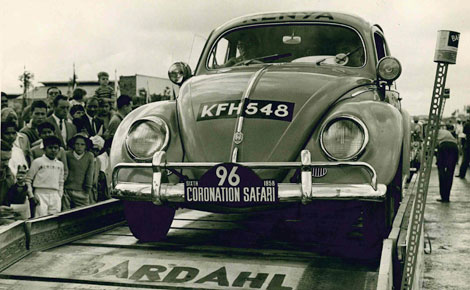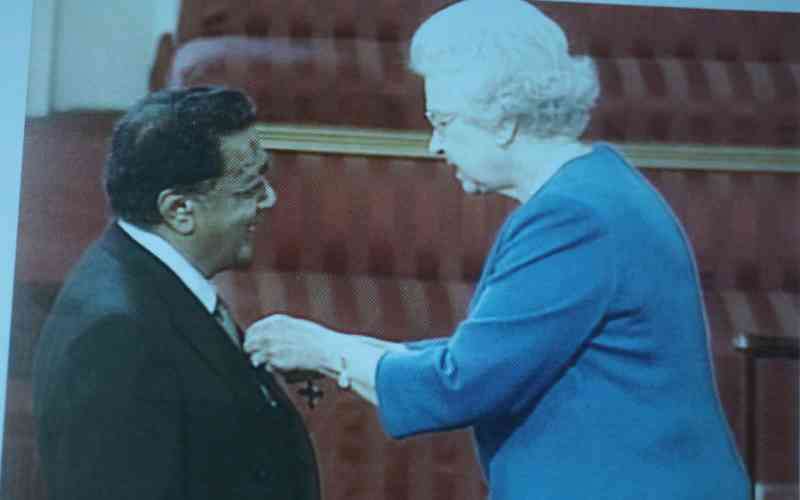 |
|
One of the vehicles that participated in the 1953 Coronation Safari. |
By Joseph Karimi
Kenya: To celebrate the Coronation of Queen Elizabeth on June 2, 1953 at the Westminster Abbey, a small group of local European motor sport enthusiasts organised the first motor rally dubbed ‘The Coronation Safari’ to become the precursor of the world famous motor sport; the Safari Rally.
The idea of a rally to commemorate the Queen’s Coronation was quite fitting in a leading British colony since Princess Elizabeth ascended to the throne while holidaying in Kenya. She and her husband Prince Philip were at Nyeri’s Treetops Hotel during the night of February 5 and 6, 1952, when news of her father’s death reached them. At this moment, thousands of miles away in London, King George VI died in his sleep, and the title of monarch passed to his daughter in Kenya. Immediately, frantic efforts began to send the news to Kenya.
When the telegram arrived, the Princess was still at Treetops, and she descended to the forest floor as the new Queen of England.
There was a 16-week period of mourning the King and the coronation of the young Queen came a year later on June 2, 1953, at the height of the Mau Mau liberation war in Kenya.
The rally attracted a lot of interest among motor sportsmen and women as the Kenya Colony was a popular destination among the Commonwealth countries.
Participation by local drivers favoured local white settlers and their families rather than indigenous Africans because social contact was prohibited under the prevailing colour bar regulations. Ownership of a motor vehicle was restricted to the white minority.
The first overseas entry came in 1957 and the number increased to 35 overseas drivers and navigators by 1962.
The first batch of local indigenous African rally drivers to participate in the 8th Coronation Safari of 1960 were Mr Danson Kiunge Mundia and his co-driver the late Karanja wa Njau, sponsored by Hughes Limited. There were among the 125 starters most of whom gave up due to bad roads and wet weather conditions which rendered some stretches impassable.
Kiunge who worked for Pollman’s Tours and Safaris and also Abercrombie & Kent Ltd said in an interview this year said that their Zephyr Zodiac endured the grueling safari of rough and tough routes to finish the three leg’s stretches: Nairobi-Kampala; Kampala-Nairobi; Nairobi –Dar; and Dar-Nairobi.
The rally’s starting point was the space now occupied by the Kenyatta Conference Centre and the Parliament Buildings.
Kiunge said that the 1960 Coronation Safari was truly an East African Rally. “It was grueling and eventful. On being flagged off, we headed for Narok, crossed over Tipis and Mau Narok hills to Timboroa. We then drove through Burnt Forest to Eldoret, Kapsabet and on to the Kisumu and Busia border point. Crossing on to Uganda we reached Majaji, then Jinja, Kawolo Trading Centre then the grounds of the Police College, Uganda, ending the first leg,” Kiunge narrated.
They were flagged after a rest for the 2nd Leg towards Nairobi. “We now headed to Tororo and crossed over to Kitale and headed for Kapenguria, Tabach, Iten, Tangro Bay on Lake Baringo, Maralel, Nyahururu to Naivasha. The route then took us towards Narok, Ngong and Kiserian and through Lang’ata to the Law Courts.”
The third leg saw the rally competitors flagged off outside Nairobi Law Courts for Namanga, Arusha, Moshi, Himo, Kaleli, Korogwe, Charanten to Kilombelo and to Dar es Saalam.
After another deserved rest, the drivers left Dar for Bagamoyo, Tanga, Msabweni, Shimba Hills to Ndii. They raced up to Voi, Mtito Andei to Kibwezi, headed for Ikutha then Mathii to Machakos and then to the finishing point outside the Nairobi Law Courts.
Stay informed. Subscribe to our newsletter
Finishers were well rewarded. “Though we emerged in 84th position, we received a Cup for finishing the race and a token of Sh 2,500 each. I added this token to my savings to buy my own car: a Volks Wagon Beatle for Sh6,500. It was a new car registration number KKF 116,” he said.
After using the VW for about one year, he sold it and bought another car.
Mr Kiunge remembered how he walked into a motor vehicle showroom owned and managed by Europeans: “There were two white men and a lady. I suspected the white men ignored me because they assumed an African could not raise money to buy a car. The two went on with their business. After a while, the young white lady came and asked me what I wanted.
Sh6,000 for a car
“I want to buy a car, I told her. She was not convinced and asked me: ‘Who is going to buy it for you? What Company is buying it for you?’ I was not amused and replied just in time: ‘I don’t want anybody to buy it for me…I will do it myself’,” he said.
The lady walked to the sales manager’s office and told him of Kiunge’s mission. He was allowed in and faced the European sales manager. “He told me the price of the Peugeot 404 Station Wagon which I wanted to buy was Sh6,000. I put my hands in my pockets and placed the cash on his table.
My Peugeot 404 Station Wagon bore the registration plate number KHE 41. A cushion was fitted on the driver’s seat and I filled the tank to capacity. It rolled out of the show room and I drove off.”
Motor vehicle sales rose tremendously with the craze of Mzee Jomo Kenyatta’s release from detention in September 1961, which was coincidentally celebrated with the release of vehicle registration numbers KHA ….translating “Kenyatta Home Again!” Wealthy Kenyans bought new vehicles to memorialise the registration adding political flavour to the gains of Kenya’s liberation.
Eventually, the Coronation Safari became the Safari Rally and a company was registered under Safari Rally Limited to take over the event from the Automobile Association of Kenya in 1979.
 The Standard Group Plc is a
multi-media organization with investments in media platforms spanning newspaper
print operations, television, radio broadcasting, digital and online services. The
Standard Group is recognized as a leading multi-media house in Kenya with a key
influence in matters of national and international interest.
The Standard Group Plc is a
multi-media organization with investments in media platforms spanning newspaper
print operations, television, radio broadcasting, digital and online services. The
Standard Group is recognized as a leading multi-media house in Kenya with a key
influence in matters of national and international interest.
 The Standard Group Plc is a
multi-media organization with investments in media platforms spanning newspaper
print operations, television, radio broadcasting, digital and online services. The
Standard Group is recognized as a leading multi-media house in Kenya with a key
influence in matters of national and international interest.
The Standard Group Plc is a
multi-media organization with investments in media platforms spanning newspaper
print operations, television, radio broadcasting, digital and online services. The
Standard Group is recognized as a leading multi-media house in Kenya with a key
influence in matters of national and international interest.



